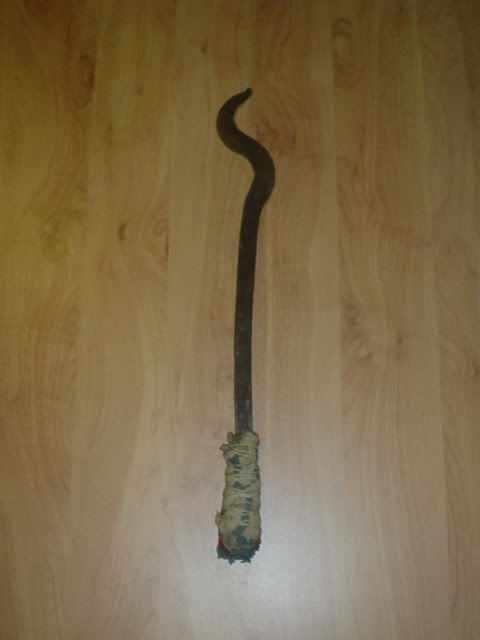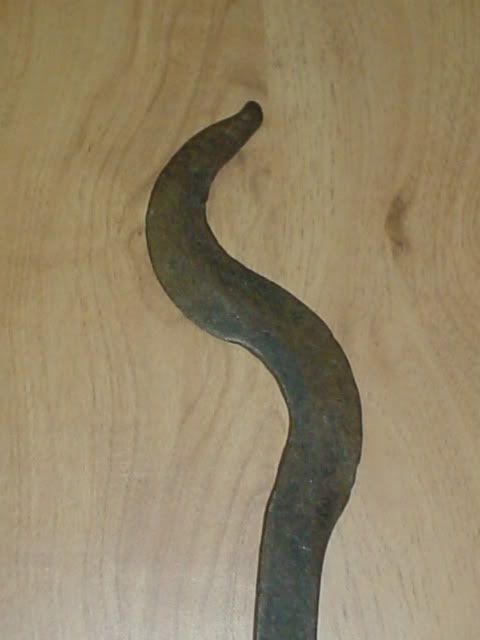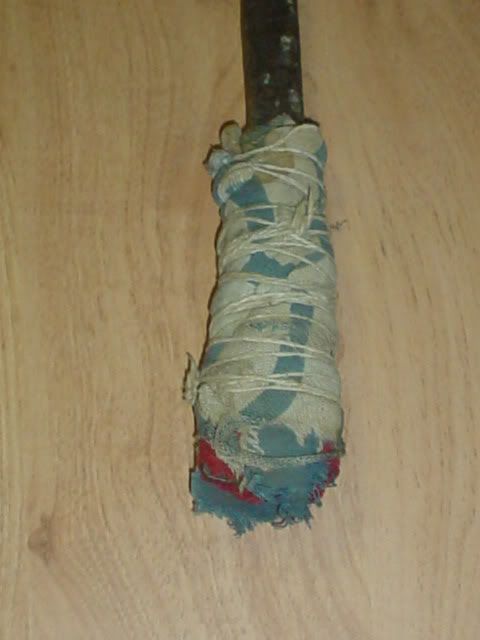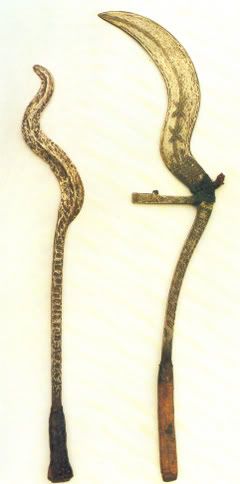
 |
|
|
#1 |
|
Member
Join Date: Dec 2004
Location: 2008-2010 Bali, 1998-2008 USA
Posts: 271
|
Many blades from many parts of the world are forged waved, from the kris and keris of the Malay world to European daggers to Hindu blades. I came to the conclusion of the waved blade being pure fashion statement but I want to challenge other opinions of any opinions, pros and cons of a waved blade. In European culture wavy blades seem to retain the names like “flamberge”, "flambards" or "flammards", basically meaning flamming.
The only difference is perhaps that a same sword with a waved blade would rather give a more of a chopping cut versus a traditional slashing cut of a standard blade. Few examples: 1. A Keris luk (property of Arts d’Orient www.artsdorient.com) 2. Photo of a Transylvanian dagger from the 17th century at the Timisoara Museum 3. A 3d screenshot of a Landesknecht “flamberge” blade two hand sword http://www.artsdorient.com/images/RIF_2240.JPG http://www.vikingsword.com/vb/attach...tid=1585&stc=1 http://www.5stardeal.com/website/swo.../20-ics010.jpg Last edited by Rick; 31st January 2006 at 04:45 PM. |
|
|

|
|
|
#2 |
|
Member
Join Date: Dec 2004
Location: Bay Area
Posts: 1,729
|
This is a bit aside, but I wonder if there is an African edged weapon with a wavy blade? I, so far, do not think I have seen one neither in Spring's book, nor in this forum, which is probably strange considering the great variety and symbolism associated with weapons from Africa.
|
|
|

|
|
|
#3 |
|
Vikingsword Staff
Join Date: Nov 2004
Posts: 6,378
|
Putting all symbolism aside :
As a thrusting weapon I'd imagine that a keris luk (wavy) would do more damage to your innards than a straight blade ; might make a larger entrance wound too ; but the point (no pun intended Jose  ) may be moot as it only takes 2.5 inches of penetration to effect a fatal wound to the torso . ) may be moot as it only takes 2.5 inches of penetration to effect a fatal wound to the torso .The perception that the kris of the Moros in its waved form is more demanding for effective use seems prevalent ; but that does not tell us whether if used properly the wound was more devastating or not . A wavy kris has a longer edge than a straight one and is used differently than the Keris of Jawa . With the huge European Zwiehanders the waves might make parrying a pike thrust a little easier . |
|
|

|
|
|
#4 |
|
Member
Join Date: Dec 2004
Location: What is still UK
Posts: 5,930
|
The only wavy African weapons I have seen are those of the Mahdist Sudan, versions of Indo/Persian tridents and the like, there could be a question as to whether they are all functional. Tim
|
|
|

|
|
|
#5 |
|
Member
Join Date: Dec 2004
Location: Sint-Amandsberg (near Ghent, Belgium)
Posts: 830
|
It's surely African and is it wavy enough ?
 It's a throwing knife from the Zulgo tribe in East Sudan. Length : 53 cm. The handle is made from cloth.    Freddy 
|
|
|

|
|
|
#6 |
|
Member
Join Date: Dec 2004
Location: Sint-Amandsberg (near Ghent, Belgium)
Posts: 830
|
Here are some others. Not in my collection, though
  Both are also Zulgo (from the book 'Rare African Short Weapons' by Manfred A. Zirngibl). |
|
|

|
|
|
#7 | |
|
Member
Join Date: Dec 2004
Location: 2008-2010 Bali, 1998-2008 USA
Posts: 271
|
Quote:
|
|
|
|

|
|
|
#8 |
|
Member
Join Date: Jul 2005
Location: Toronto, Canada
Posts: 1,242
|
Hello Radu, hello all,
Wouldn't wavy blades be more effective at draw cuts than straight blades? Much like the falx and all those sickle weapons, the pulling/cutting motion would pull the convex blade deeper into the object being cut, no? For beasts like the zweihander draw-cuts may not be feasible but how about the smaller blades? IMO the waves of these large flamberge swords were more aesthetic - the symbol of Archangel Michael's flaming sword in battle would be an awesome sight- than functional. Is the parying advantage of the wavy blades that important, or is it negligible? Regards, Manolo |
|
|

|
|
|
#9 |
|
Member
Join Date: Dec 2004
Location: 2008-2010 Bali, 1998-2008 USA
Posts: 271
|
CONCLUSION - ITS MORE FOR THE ESTHETICS ! Unless any groundbreaking info, its a closed chapter !
|
|
|

|
|
|
#10 |
|
Member
Join Date: Dec 2004
Posts: 221
|
I'm not sure you can throw every blade with a wave in the same category as a "fashion or esthetic statement". The Moro kris "swords" with or without waves were both effective combat weapon, maybe more a matter of form and fighting preference.
|
|
|

|
|
|
#11 |
|
Member
Join Date: Dec 2004
Location: 2008-2010 Bali, 1998-2008 USA
Posts: 271
|
Mabagani, with all respect to the traditional or spiritual, does a waved blade inflict a deeper cut, a longer cut or presents any advantages other than visual over the classic cutting edge?
I find elements like weight, shape, curvature, length, sharpness, material type to make a crucial difference but a waved edge does not seem to change eficacity. The most honest working waved blades I see it in the Moro Keris and the Landesknecht which seem to not loose their capacity of combat eficiency but those like some African or Hindo-Persian weapons have nothing but to loose by keeping the blade shape in cause and so far I am convinced its nothing but a matter of esthetics, likely the case with absolutelly all of them. In the case of the Moro (Tausug) blades is there any action or effect waved ones can inflict and the others cannot ? Waved blades have nothing in common with saw or serrated blades in case anyone tries to open that up... |
|
|

|
|
|
#12 |
|
Member
Join Date: Dec 2004
Posts: 221
|
Setting aside tradition and spiritual aspects, etc., and looking at it from the point of combat, when the Moro kris is in its scabbard in most cases one wouldn't really know whether or not its straight, wavy, wavy straight, saber, etc. only a general idea of the length and what you'd expect looking at the opponent. Once the sword is drawn and it is a wavy kris, the things to watch out for are the cuts which need to enter flesh and bones at a certain angles to cause the most damage, the krismen are going for a kill or to inflict the most damage with every shot, cutting or thrusting, with this in mind the matter of asthetics and fashion in or out of the scabbard are moot points. btw The cutting action of a wavy kris is kind of like cutting wood, flesh and bone at an angle with the grain but the perpendicular bouncing drag shot could have been advantageous against multiple opponents and in close quarters, like the kampilan, perhaps why numerous wavy kris are seen in old photos and collections. Again, its a matter of preference and custom fitting, I've seen wavy kris swords from heavy to light and long to short, each is going to have its varying degree of action and effect depending on the depth of the waves and frequency, regardless of the weapon it'd be the same intention if its a true Moro swordsman trying to severe limbs, decapitate and kill using whatever they had at the moment, so the Tausug saying goes...
Last edited by MABAGANI; 2nd February 2006 at 08:00 AM. |
|
|

|
|
|
#13 | |
|
Member
Join Date: Dec 2004
Location: Cincinnati, OH
Posts: 940
|
Quote:
 I guess it's a case of "If a wavy kris cuts in the forest and no one is there to see it bleed more (or less...or the same) than a straight blade does it really cut at all?  It seems to me that there needs to be a whole lot more scientific experimentation before we can come to any real conclusions on this one, don't you think? 
|
|
|
|

|
|
|
#14 |
|
Member
Join Date: Dec 2004
Location: 2008-2010 Bali, 1998-2008 USA
Posts: 271
|
Welcome, welcome ...
 The arguments not the accusations, please... Point the theory not the finger, dear ol' chap The arguments not the accusations, please... Point the theory not the finger, dear ol' chap  I opened the discussion, remember? I opened the discussion, remember? Its true, I cannot expect anyone to sacrifice his old weapon or worse  God forbid his limbs, (any volunteers? God forbid his limbs, (any volunteers?  ) I dont think much ground has been covered on testing such blades. And I doubt battle accounts in the matter are written on paper... ) I dont think much ground has been covered on testing such blades. And I doubt battle accounts in the matter are written on paper...One thing for sure, a waved blade must be a lot harder to sharpen evenly... |
|
|

|
|
|
#15 |
|
Member
Join Date: Dec 2004
Location: Cincinnati, OH
Posts: 940
|
Sorry Radu, i wasn't trying to do any finger pointing. Of course i remember that you opened the thread. That's why i was wondering why you were trying to close it out so quickly. Generally that's what i assume when someone says,"...it's a closed chapter."
You are probably right, it might be a lot harder to sharpen a wavy blade evenly. But somehow the Moro know the trick because my wavy example is sharp as a razor all along it's length.  Perhaps testing could be done on materials that approximate the texture and hardness of flesh. Anyone have any ideas? |
|
|

|
|
|
#16 | |
|
Member
Join Date: Jun 2005
Posts: 210
|
Quote:
n2s |
|
|
|

|
|
|
#17 | |
|
Member
Join Date: Feb 2006
Posts: 18
|
Quote:
do to hobbie mishap "I found out the sharp way" 
|
|
|
|

|
|
|
#18 |
|
Member
Join Date: Feb 2006
Posts: 18
|
I can say this, they look good on my wall " I get neat remarks about it", and all my buddys cant keep there fingers of it..

|
|
|

|
|
|
#19 | |
|
Member
Join Date: Dec 2004
Location: Cincinnati, OH
Posts: 940
|
Quote:
|
|
|
|

|
|
|
#20 |
|
EAAF Staff
Join Date: Dec 2004
Location: Louisville, KY
Posts: 7,352
|
I'm inclined to agree with Mabagani. Against flesh a glancing blow with a kris could seem like large saw teeth, but the problem is the bouncing affect, especially against any armour (which only datus could afford). But against multiple opponents one would not want to spend too much time making too deep of cuts on any one person but hit as many as possible multiple times. Depends on the style and the skills of the warrior in question.
|
|
|

|
|
|
#21 |
|
Arms Historian
Join Date: Dec 2004
Location: Route 66
Posts: 10,687
|
It seems pertinant to note in this case that there are distinct differences in wavy or undulating blades and those which are serrated. While the wavy form in blades appear to be for effect, it is known that close serration on cutting knives is considered effective.
In most cases it is presumed that 'wavy' blades are mostly associated with ceremonial purpose, however Burton (p.137) suggests in discussing the wavy blade that, "...the object seems to be that of increasing the cutting surface". The term 'flamberge' in the 8th c. was applied in France to nickname the sword of the knight Renaud de Montauban, meaning flamboyant. The term flammard by 13th c. had become used to describe knightly swords, and alluded to the flaming sword described in Biblical literature. It would seem that that symbolism was applied literally in the wavy blades seen on the huge landsknecht swords, without actual practical value being considered. Swords with serpentine or undulating blades in India are of course of Nagan symbolism. Dr.Yusel in his "Islamic Swords and Swordsmiths" (p.139) notes,"...highly unusual serpentine shaped swords that began to appear in the Ottoman world from the time of Sultan Bayezid II onwards. It seems hard to imagine that these swords had a use other than ceremonial". In Pant (p.56-57) discussing nagan type swords, he notes serrated zig zag blades and that "...it is said that these swords were used against armour, but since these were not found very suitable by soldiers, abandoned in the late 17th c. AD". In considering the purpose of the luk, or waves, on the blades of the Keris, I would defer to the knowledge of those enthusiasts here, however it is my impression that the number of these 'luk' is significant in symbolism in the blade itself. It is important to also consider toothed, or saw type blades, typically intended for utility or practical purposes on bayonets and the short swords of pioneers in military units. These dual purpose weapons were often misperceived as barbaric weapons to cause horrific wounds, but of course were more tools than weapons, and were quite impractical in that use. Despite the earlier case closed status on this topic, I simply wanted to add more detail on why the wavy, undulating or serpentine (nagan) blade would be more likely considered ceremonial or symbolic. While the toothed or saw blade would be somewhat impractical in most cutting or especially thrusting action, the serrated blade may have guaged functional merit. Best regards, Jim |
|
|

|
|
|
#22 |
|
Member
Join Date: Dec 2004
Location: 2008-2010 Bali, 1998-2008 USA
Posts: 271
|
Jim, if you ever see a cat burglar running out trough the window with a bunch of your books from your library, please dont aim for the head. It could kill me...

|
|
|

|
|
|
#23 |
|
Member
Join Date: Dec 2004
Location: Cincinnati, OH
Posts: 940
|
Jim, Thanks for your usual level of scholarly research. I have always appreciatedyour diligence in keeping this an academic forum. I find little argument with most of what you stated, but it still must be pointed out that to the Moro the wavy or undulating blade was combat ready, not merely ceremonial. And no one can doubt the levels of effectiveness they brought to that form.

|
|
|

|
|
|
#24 |
|
Arms Historian
Join Date: Dec 2004
Location: Route 66
Posts: 10,687
|
Hi Nechesh,
Thank you so much for the kind words. Point well taken on the Moro kris, and I'm glad you noted that,these weapons were indeed used most effectively by these fierce warriors. In reviewing Robert Cato's outstanding article in "Arts of Asia" in Jan/Feb 1991, "Islamic Swords of the Southern Philippines", he notes that all of the three basic forms of Moro kris blade carry nagan representation. In this the straight blade example (sundang espada), actually is intended to represent the serpent at rest, while the other two with degrees of undulation represent it in varying stages of motion. The Moro kris is truly an exceptional example of a weapon which often carries varying degree of undulation in its blade, and is clearly a fighting example of sword carrying such symbolism. That it was effective is well marked by the fact that the Moro's remained unsubdued for over three hundred years, and thier ferocity in battle legendary. All best regards, Jim |
|
|

|
|
|
#25 |
|
Arms Historian
Join Date: Dec 2004
Location: Route 66
Posts: 10,687
|
Thanks Radu JUDL!
If ya made it through the minefield, barbed wire, guard dogs and lasers, I'd be compelled to let you go!!!  Best regards, Jim |
|
|

|
|
|
#26 |
|
Member
Join Date: Dec 2004
Location: Ann Arbor, MI
Posts: 5,503
|
Well, both straight and wavy blades deserve respect as long as they do not look like this mutilated abomination!
http://cgi.ebay.com/ws/eBayISAPI.dll...MEWA%3AIT&rd=1 |
|
|

|
|
|
#27 |
|
Member
Join Date: Jan 2006
Posts: 123
|
I'm just taking a crack shot, but aren't they for decoration and a symbol of courage...maybe they used them as a psychological weapon to psych themselves up. The wave blades...to me...look like fire, maybe hot flame rising. If you look at Thai designs and patterns, you'd see pattern of bright golden flame; I guess it is supposed to be very hot. The reason for that is they like to think they have conquered all fear by staying pured, doing good deeds by following the teaching of Buhddism, which the flame represents in the paintings, carving, and patterns on the temples. This is probably why the Siamese were the toughest fighters in Southeast Asia. In a few chapters, they talk about a couple thousands villagers, who fought part of the Burmese armies that range from twenty to thirty thousand troops. In the end all of them died fighting! You have the Celts in Gaul, which outnumbered the Roman ten to one, and they still fear them, and in the end they panic and fled, which gave Julius Ceaser a great victory and tremendous amount of respect at home. No offense to all you Celts, ofcourse!
 
|
|
|

|
|
|
#28 | |
|
Member
Join Date: Feb 2006
Posts: 18
|
Quote:
 Think of that kind of damage 
|
|
|
|

|
|
|
#29 |
|
Member
Join Date: Dec 2004
Location: NC, U.S.A.
Posts: 2,207
|
One could always test some of the theories out on a helpless cassaba melon or two! I remember that Alfred Hitchcock used cassaba melons being stabbed to simulate the sound of a perforating knife in the original Psycho movie. In my opinion, there's no question of the damage a Moro kriss, wavy or straight, could do to a man (case in point, American GI's during the Spanish American war). As far as serrated weapons go, I remember a discussion from a number of years back concerning Kingsmill Island swords (tebutji?) with the shark teeth and quite a few varying opinions. For my part, I have taken a saw and wacked off a smaller tree limb and the saw bit pretty deep into the bark as well (probably as deep as many swords I've welded). That being said, i could see where a curved blade would be totally impractical on horseback as it might bite deep and not pull free. Does anyone feel that a wavy bladed sword might have a tendency to stick in a chest cavity more than a straight blade? Just curious...
|
|
|

|
 |
| Thread Tools | Search this Thread |
| Display Modes | |
|
|